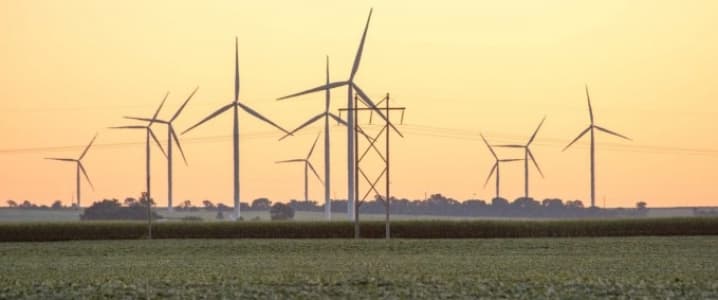Wind energy is changing the economy of the Midwest. Wind is the fastest growing source of electricity in the United States, and about 70 percent of wind power is located in low income counties. These counties are typically rural, often Midwestern areas, where the dominant industry for decades has been agriculture. Increasingly though, many farmers are finding that leasing space to wind turbine operators is more lucrative than growing corn. That trend is likely to continue going forward, and it should alter the way energy companies and investors alike should think about wind power.
Wind power represents an important economic boost in many areas of the U.S. and as a result local farmers and communities welcome wind turbine developers. Farmers benefit directly from wind turbines to tune of between $7,000 and $10,000 per turbine in annual leasing fees. A farmer who could lease land for 10 wind turbines would likely receive between $70K and $100K in annual lease income with essentially no overhead for that income.
Farmers are not the only beneficiaries however. Communities as a whole benefit directly from wind farm development as well. A two MW wind turbine can carry a tax assessment value of $720,000. If a community can host 100 turbines across farms throughout the county, that equates to an additional $72 million in property tax values which in turn provides an enormous influx of cash for renovating schools, upgrading infrastructure, and adding new services for local residents. The average U.S. property tax rate is around 2 percent, meaning that 100 two MW wind turbines would generate $1.4 million in property tax revenue annually – enough to pay for more than $40 million in local improvements at typical muni cap rates.
Nationally, there are more than $100 billion of wind farm investments with more on the way, and rural land owners will likely receive around $1 billion in lease payments annually by 2030 according to some estimates. Against this backdrop and given the value that wind power provides to rural communities as a whole, it is little wonder that wind power projects are quite popular in most rural towns. Related: OPEC Deal Still Wobbly, But Oil Investment Takes Off
The popularity of wind projects with the residents of these areas is important because, unlike most other forms of power production (including solar power in some areas), wind turbine developers get significantly less pushback from local NIMBY protesters. Add to that the extension of the five-year wind tax credit which passed Congress last year, and the wind power business looks likely to continue to be strong for years to come. Congress’ tax credit pays wind power producers $0.023 per kwh of power produced for a 10-year period. Bloomberg estimates the credit will lead to a doubling of the current ~83 GW of wind power by 2030.
Add together the supportive regulatory environment and clamor by local residents for more wind turbines, and its little wonder that wind is one of the best areas of the power generation markets right now. Investors can capitalize on the trend either with large diversified conglomerates like Berkshire Hathaway which owns wind power producer MidAmerican Energy, or with pure play power producers like Alliant Energy. Both approaches have merit depending on one’s investment philosophy, but investors should look closely at one path or the other because strong secular growth stories in the energy business are in short supply at present.
By Michael McDonald of Oilprice.com
More Top Reads From Oilprice.com:
- U.S. Ease On Cuban Sanctions To Benefit Foreign Oil Producers
- Oil’s Biggest Threat: Demand To Peak Within 15 Years
- Saudi Arabia Reports Lower Output, Exports In August


















